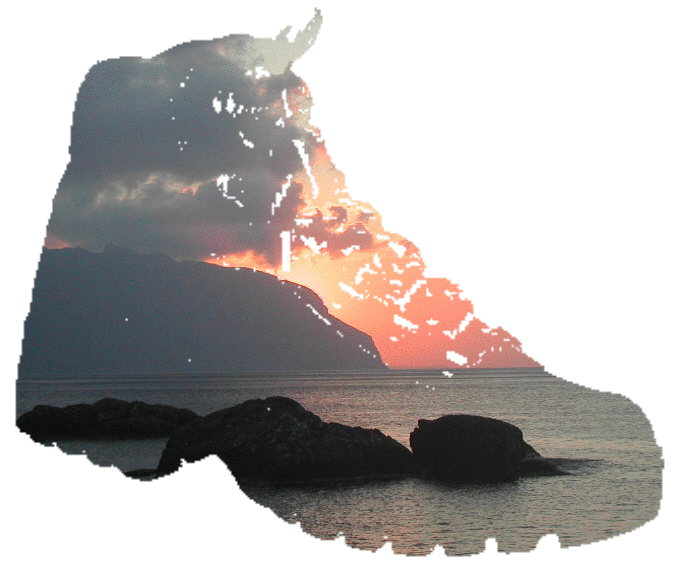Amorgos
Amorgos is a narrow, rocky finger of an island with a barren south coast where 300 metre cliffs plunge into the sea. The north coast is indented, notably by the large bays of Katapola, the major port and Aeghiali. Communication between them used to be solely by sea but since 1990 a mountain road has linked all the main settlements on the island.

Amorgos has
-
varied scenery, vigorous walking terrain, a scattering of archaeological sites, very few beaches
-
two major claims to fame - the Byzantine Chosoviotissa monastery, hanging on 300m sea cliffs and locations that feature in Luc Besson's 1988 cult film Le Grand Bleu (The Big Blue)
-
an extensive network of waymarked paths using the old mule roads (monopatia)
-
scattered communities with choices of accommodation over its entire length, making linear day hikes practical
-
wonderful spring and autumn flowers, cultivated valleys and slopes, and springs and wells
-
in summer the cooling Meltemi (northerly wind) makes hill-walking enjoyable
Getting to Amorgos
-
From Piraeus: sailings to Katapola or Aeghiali 3 to 5 days per week. The fastest ferry, the Blue Star , sails non-stop to Katapola in 5 hours. The other ferries take between 5 and 12 hours. Greek Travel Pages and Greek Island Hopping provide timetables.
-
From Naxos: Every day, ferries cross from Naxos, sailing time 1-3 hours.
-
You can reach Naxos from Athens by air using Olympic Airways or by ferry from Piraeus, journey time around 5 hours.
-
A few hydrofoils link Amorgos with Santorini and the south-western Cyclades in the summer.
Getting around Amorgos
-
Amorgos is like a 35Km long knife lying northeast - southwest with a central spine which rises to 820m towards the north and hardly drops below 300m for most of its length.
-
There are fewer small ports and fishing villages and much less boat traffic than is found on most other islands.
-
A tarmac road, though steep and twisty, links all settlements and buses run a few times a day. Vehicles can be hired in Aeghiali and Katapola.
-
The south coast is a virtually unbroken line of towering cliffs, rising in places to 400m. Traces remain of the ancient forest, destroyed by fire in 1835, but the seaward slopes are mostly bare rock, inaccessible from land.
-
There are only two places where you can easily get down to the sea on this southern coast, and three more difficult access points along the entire 35Km length. Some advanced walks may tempt experienced island walkers!
.
Staying on Amorgos
-
Upon arrival, you should find accommodation at the main port of Katapola.
-
Venturing farther afield, there’s accommodation in the peaceful old Chora 300m above the port, the second port of Aeghiali an hour’s drive to the north with the mountain villages of Tholaria and Langadha up in the hills behind.
-
South from Chora is an area of undulating pastures, surrounded by rounded limestone hills with the scattered communities of Vroutsi, Kamari, Arkesini and Kolofana, known collectively as Kato Meria (the low places), where there is a little accommodation and the very occasional taverna and general store, but a wealth of ruins, chapels and coves, including sandy Kalotaritissa Bay at the very southern tip.
Maps and other information
We recommend the Anavasi Topos map, at 1:25,000 ISBN960-8195-31-4, for walking, and the Skai Terrain map, at 1:35,000, Product code: PXAPAMO.
Also don’t forget Google Earth gives you a satellite view, which is fascinating.
There’s a number of guidebooks, including:
-
Tassos Anastassiou; Amorgos: History, Sightseeing, Hermoupolis 1996 An authoritative general guide to the island.
-
Tassos Anastassiou; A Travelogue of Amorgos (1994) ISBN 960 85540-8-X. This was published in 1994 and distributed on the island but was never offered for sale. There’s a copy in the Apanemos Taverna at Kolofana.
-
Yiannis Desypris; Amorgos, the Island of the Big Blue, 2002, pub Toubis ISBN 960-540-439-7
-
Lila Marangou; The Monastery of the Panayia Khosoviotissa, Athens 2002 (4th edition) which is a very detailed read about the monastery.
Also a travel writer lives on the island, and has published two books about it:
-
Carola Matthews The Mad Pomegranate Tree, an Image of Modern Greece, Macmillan 1968 (now out of print)
-
Carola Matthews At the Top of the MuleTrack, Macmillan 1971 (now out of print, this book is all about life in Langadha in the 1970s)
www.amorgos.com is a source of general tourist information for Amorgos:

